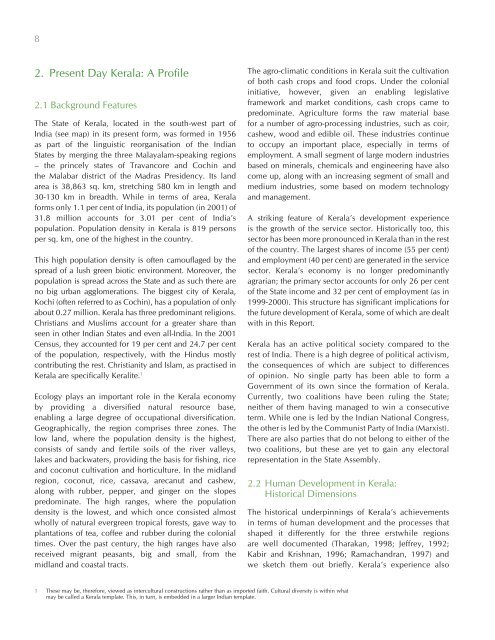Kerala 2005 - of Planning Commission
Kerala 2005 - of Planning Commission
Kerala 2005 - of Planning Commission
You also want an ePaper? Increase the reach of your titles
YUMPU automatically turns print PDFs into web optimized ePapers that Google loves.
8<br />
2. Present Day <strong>Kerala</strong>: A Pr<strong>of</strong>ile<br />
2.1 Background Features<br />
The State <strong>of</strong> <strong>Kerala</strong>, located in the south-west part <strong>of</strong><br />
India (see map) in its present form, was formed in 1956<br />
as part <strong>of</strong> the linguistic reorganisation <strong>of</strong> the Indian<br />
States by merging the three Malayalam-speaking regions<br />
– the princely states <strong>of</strong> Travancore and Cochin and<br />
the Malabar district <strong>of</strong> the Madras Presidency. Its land<br />
area is 38,863 sq. km, stretching 580 km in length and<br />
30-130 km in breadth. While in terms <strong>of</strong> area, <strong>Kerala</strong><br />
forms only 1.1 per cent <strong>of</strong> India, its population (in 2001) <strong>of</strong><br />
31.8 million accounts for 3.01 per cent <strong>of</strong> India’s<br />
population. Population density in <strong>Kerala</strong> is 819 persons<br />
per sq. km, one <strong>of</strong> the highest in the country.<br />
This high population density is <strong>of</strong>ten camouflaged by the<br />
spread <strong>of</strong> a lush green biotic environment. Moreover, the<br />
population is spread across the State and as such there are<br />
no big urban agglomerations. The biggest city <strong>of</strong> <strong>Kerala</strong>,<br />
Kochi (<strong>of</strong>ten referred to as Cochin), has a population <strong>of</strong> only<br />
about 0.27 million. <strong>Kerala</strong> has three predominant religions.<br />
Christians and Muslims account for a greater share than<br />
seen in other Indian States and even all-India. In the 2001<br />
Census, they accounted for 19 per cent and 24.7 per cent<br />
<strong>of</strong> the population, respectively, with the Hindus mostly<br />
contributing the rest. Christianity and Islam, as practised in<br />
<strong>Kerala</strong> are specifically Keralite. 1<br />
Ecology plays an important role in the <strong>Kerala</strong> economy<br />
by providing a diversified natural resource base,<br />
enabling a large degree <strong>of</strong> occupational diversification.<br />
Geographically, the region comprises three zones. The<br />
low land, where the population density is the highest,<br />
consists <strong>of</strong> sandy and fertile soils <strong>of</strong> the river valleys,<br />
lakes and backwaters, providing the basis for fishing, rice<br />
and coconut cultivation and horticulture. In the midland<br />
region, coconut, rice, cassava, arecanut and cashew,<br />
along with rubber, pepper, and ginger on the slopes<br />
predominate. The high ranges, where the population<br />
density is the lowest, and which once consisted almost<br />
wholly <strong>of</strong> natural evergreen tropical forests, gave way to<br />
plantations <strong>of</strong> tea, c<strong>of</strong>fee and rubber during the colonial<br />
times. Over the past century, the high ranges have also<br />
received migrant peasants, big and small, from the<br />
midland and coastal tracts.<br />
The agro-climatic conditions in <strong>Kerala</strong> suit the cultivation<br />
<strong>of</strong> both cash crops and food crops. Under the colonial<br />
initiative, however, given an enabling legislative<br />
framework and market conditions, cash crops came to<br />
predominate. Agriculture forms the raw material base<br />
for a number <strong>of</strong> agro-processing industries, such as coir,<br />
cashew, wood and edible oil. These industries continue<br />
to occupy an important place, especially in terms <strong>of</strong><br />
employment. A small segment <strong>of</strong> large modern industries<br />
based on minerals, chemicals and engineering have also<br />
come up, along with an increasing segment <strong>of</strong> small and<br />
medium industries, some based on modern technology<br />
and management.<br />
A striking feature <strong>of</strong> <strong>Kerala</strong>’s development experience<br />
is the growth <strong>of</strong> the service sector. Historically too, this<br />
sector has been more pronounced in <strong>Kerala</strong> than in the rest<br />
<strong>of</strong> the country. The largest shares <strong>of</strong> income (55 per cent)<br />
and employment (40 per cent) are generated in the service<br />
sector. <strong>Kerala</strong>’s economy is no longer predominantly<br />
agrarian; the primary sector accounts for only 26 per cent<br />
<strong>of</strong> the State income and 32 per cent <strong>of</strong> employment (as in<br />
1999-2000). This structure has significant implications for<br />
the future development <strong>of</strong> <strong>Kerala</strong>, some <strong>of</strong> which are dealt<br />
with in this Report.<br />
<strong>Kerala</strong> has an active political society compared to the<br />
rest <strong>of</strong> India. There is a high degree <strong>of</strong> political activism,<br />
the consequences <strong>of</strong> which are subject to differences<br />
<strong>of</strong> opinion. No single party has been able to form a<br />
Government <strong>of</strong> its own since the formation <strong>of</strong> <strong>Kerala</strong>.<br />
Currently, two coalitions have been ruling the State;<br />
neither <strong>of</strong> them having managed to win a consecutive<br />
term. While one is led by the Indian National Congress,<br />
the other is led by the Communist Party <strong>of</strong> India (Marxist).<br />
There are also parties that do not belong to either <strong>of</strong> the<br />
two coalitions, but these are yet to gain any electoral<br />
representation in the State Assembly.<br />
2.2 Human Development in <strong>Kerala</strong>:<br />
Historical Dimensions<br />
The historical underpinnings <strong>of</strong> <strong>Kerala</strong>’s achievements<br />
in terms <strong>of</strong> human development and the processes that<br />
shaped it differently for the three erstwhile regions<br />
are well documented (Tharakan, 1998; Jeffrey, 1992;<br />
Kabir and Krishnan, 1996; Ramachandran, 1997) and<br />
we sketch them out briefly. <strong>Kerala</strong>’s experience also<br />
1 These may be, therefore, viewed as intercultural constructions rather than as imported faith. Cultural diversity is within what<br />
may be called a <strong>Kerala</strong> template. This, in turn, is embedded in a larger Indian template.

















